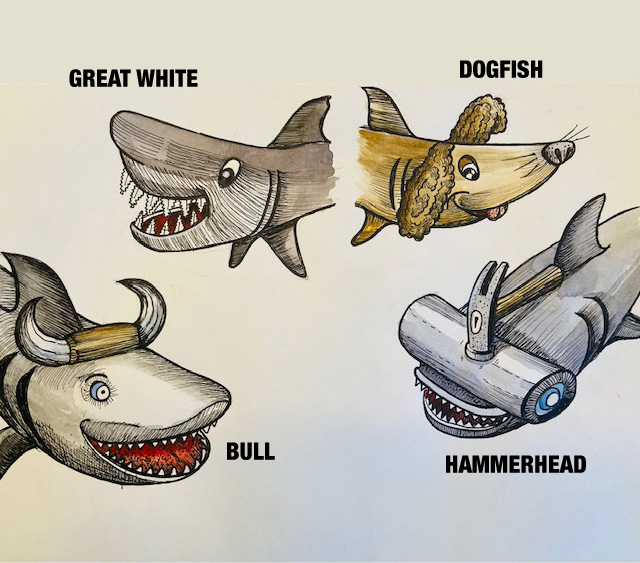
No, I don’t wanna’ be Quint and this is not about “JAWS”, It’s just an informative guide that answers the question that sunny day boaters and their guests often ask. Are there any sharks here? Knowing the person’s personality is my guide to gauge my answer. It’s a moral question to me. Do I lie to make them feel comfortable and hope some fluke fisherman near us doesn’t pull up a small, harmless spiny dogfish bringing on a guest’s hysteria, or do I just deal with their fear upfront and say “Yes, there are” adding a not entirely truthful “But they aren’t the kind that bite!’’ and still deal with a barrage of anxieties and questions.

The fact is, there are sharks in all our bays and shorelines, and they arrive according to their tolerance of water temperatures. Some loners even choose to stay all year. Since our eco-system from Cape Cod, Long Island Sound, New Jersey and New York bays and the coastal ocean are interconnected, sharks can move from deeper nearshore regions of our Atlantic Ocean and easily slip into our bays, the sound, and for a certain species even upriver beyond the saltwater diffusion line and into freshwater. More about that later.
The list of sharks that visit us from out in the Atlantic then shoreward is considerable.
BASKING SHARK is the largest shark with a length of over 40 ft. They are docile krill eaters with no teeth and are too large to get close to swimming shores and bays. I keep one as a pet in my house in a rather cumbersome fishbowl.
BLUE SHARK – Named for its bright red skin – (If you believe that, please discontinue reading!) they grow to 12 ft. in length, are toothy, and rarely come close to ocean swimming areas. I have never heard of them in the bays or rivers nor are they generally aggressive towards people in coastal areas.
DUSKY SHARK visits us. It is a toothy predator shark occasionally coming into interaction with ocean swimmers. There is a micro risk of danger, with only TWO known attacks worldwide! The risk odds? You finish a plumbing job and walk downstairs with a wet screwdriver in your hand. You tumble forward and the tip of the wet screwdriver goes smack-crack into the electric socket. You get fried! I’ll take those odds anytime.

THRESHER SHARK can grow to 25 ft. and have rather small, toothed mouths. They have very long back fins which they use to stun baitfish and then feed on them. They are non-aggressive and can come close inshore.
Three years ago, a small one visited Zacks Bay on a weekend. It was safely relocated to the sea and most everyone went back to swimming.
SAND TIGER – Grrrrrr! Scary name, huh! With a mouth of big teeth, 11 ft. length and stocky body, these sharks can be unnerving when encountered. It happened to me at Gilgo Beach during the “Jaws’ craze. He came right up to me and then swam away. Near panic, I swam back and slept on my towel the rest of the day. The sunburn I suffered from was worse than anything that non -aggressive shark could do. The Great South Bay is a nursery for their young, but they keep to themselves.
SAND BAR SHARK – These coastal sharks grow to 8 ft. but are generally in the 4-5 ft. range. They feed on small baitfish. They occasionally visit our bays but are non-aggressive, so no worry here. They stay away from people as long as you’re not wearing the new “Peanut Bunker” deodorant.
SPINY AND SMOOTH DOG FISH – These small guys grow to about 4 ft. We catch them when fishing for fluke. Casual boaters think we are catching man killers when we handle them to remove the hooks. They barely have teeth. They love steamers, stuffed and fried clams and are harmless unless you grab the spiny area when removing the hook.
NOW!!! The more aggressive sharks you’ve been waiting for!
SHORT FIN MAKO is the fastest shark clocked at 40 mph. These sharks can be a problem if they move inshore following food but rarely do. I only saw one in the surf as it devoured a giant sunfish in the surf near Kismet. The National Park Service and Robert Moses State Park closed swimming that day. I often caught them at the Angler Banks some 20 miles from Jones Inlet. They were a tussle and half to land and tasted great but as sharks became endangered, I gave up all shark fishing. There are no recorded incidents with makos in our area.
HAMMERHEAD – Named so because its head looks like a_____? They are one of the “Big Guys”, growing up to 16 ft. They visit our coast on rare occasions and have not been recorded in our bays. Over the years there have been listed 17 non-provoked, non-fatal attacks reported. It is barely a threat.
The GREAT WHITE! – Here he comes! JAWS! “We’re going to need a bigger boat” THAT JAWS! This is where legend brushes new Oceanographic Science. Capt. Quint was modeled after legendary “MONSTER FISHERMAN” Frank Mundus and his boat, Cricket II, out of Montauk when it was the fishing capital of the Atlantic. Mundus spent his life pursuing great whites, achieving world records in size. Then it was considered a rare offshore species, except when a dead whale moved closer to shore and great whites gobble auto size bites using their giant teeth.
Now our ocean is changing and with change comes a tad more danger. Ocean scientists now recognize that great whites are closer to and more numerous off our Jersey to Cape Cod shores than ever before. To date, they have not entered Long Island’s shallow bays, but they have been spotted in the Sound, New York Harbor and if they visit there, I can guarantee they visit Raritan Bay. They are all over Cape Cod. Allegedly, most are juveniles in the 17 ft. length, very toothy and built like a Mack truck. They feed on the exploding seal populations. Of late there have been attacks on swimmers and kayakers at the National Seashore on the Boston Harborside inner hook. Perhaps these attacks were humans being mistaken for the seals. Along the Atlantic beaches of New York and New Jersey, there were a few beach closings last year due to rare great white incursions.
BUT WHICH SHARK HAS THE POTENTIAL TO BE THE MOST DANGEROUS???
Why it’s the BULL SHARK! – Last year was the year of the bull shark, the most potentially lethal shark in our waters including ocean, sound, bays, New York Harbor and all freshwater rivers feeding into salt. This shark can go just about anywhere. There were 19 sightings in Nassau County alone last year. New jet ski beach patrols and lifeguards were added along the south shore. A surf fisherman caught a 400 pounder at Lido Beach. Climate change is resulting in hotter summer weather, warmer water, and flow changes in the Gulf Stream, resulting in more bait to attract bull sharks.
Bull sharks are very aggressive. With a full mouth of sharp hardware, up to 11.5 ft. in length and 500 lbs. behind them, they account for most world shark attacks. They favor shallow waters, estuaries, rivers, bays and coasts where humans gather. Bull Shark central is the Chesapeake and Delaware Bays. How long will it be before our bays become another nursery?
So that’s some of what’s beneath your hull and feet. But “FEAR NOT”!!! Actual encounters are extremely, extremely, extremely rare in our waters.
We are far more dangerous to sharks than they ever do to us. It is in our interest to protect all of them for a healthier and balanced environment.
NEXT MONTHS ARTICLE – “KILLER PERIWINKLES”
C. 2021 by Mark C. Nuccio – All rights reserved
Article and any illustrations
You can reach the author at mark@designedge.net
